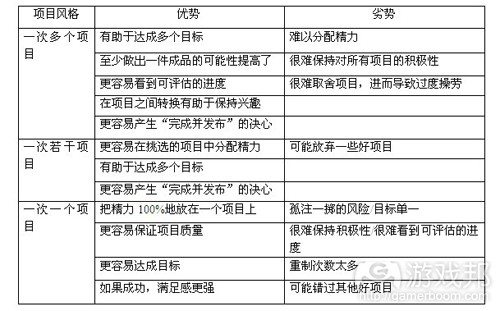阐述如何最大化业余项目的成功可能性
作者:Ben Serviss
如果你从事游戏业,那么你可能与大多数开发者一样具有狂热的主动性。制作游戏是一个充满竞争的复杂过程,你不只需要对项目的热情,还要找到完成项目的方法。
然而,无论你是想要敲开游戏业大门的学生还是追求个人进步的资深开发者,使用合理的方法来执行你的业余项目总是很有意义的;一大堆半成品和若干个圆满的代表作的区别有时候就在这里。
树立目标
“能激励我的东西就是,想象我要努力达到的成就……这是一座近在眼前高山,却又远在天边——我的目标。我知道,只要我坚持朝着这座高山走去,我就能抵达。当我茫然不知所措时,我可以暂时停下步伐,想一想自己脚下的路是正在把我带往那座高山,还是让我离它越来越远。”——Neil Gaiman(游戏邦注:英国著名的漫画编剧。)
上面这段话摘自著名作家Neil Gaiman为艺术大学2012年的毕业典礼做的演讲。虽然他谈的是职业规划,但也能启发我们明智地选择值得做的业余项目。
当考虑着手新项目时,应该先退一步思考一下这个项目是否有助于你达到游戏开发的目标。
你开始新项目的主要目标是:
*积累游戏开发的经验?
*给你的个人作品集增加内容?
*做一款能挣钱的商业产品?
*为了获得奖金、荣誉或名气而做的参赛作品?
*学习如何使用某种工作或框架?
*只是为了好玩(为了做项目而做项目)?
当你思考上述问题的答案时,你还要问问自己:这个项目是让我更加接近那座“高山”,还是让我更加远离它?
如果是团队项目,那么所有成员的目标一致吗?这一开始可能显得不太重要,但对于长期项目,一旦大家都在这个游戏中投入了时间和金钱,目标不一致就可能导致决策上的矛盾和冲突。
确定工作风格
你擅长同时处理多件事情和固定工作吗?你可以一次只专注于少量的工作而不产生错漏吗?或者你只能一次做一件工作,且不受任何干扰,才能达到最佳状态?
为了明智地为项目分配时间和精力,你必须确定什么样的工作风格最适合你。虽然这看起来似乎是常识,且在一定程度上你可能已经知道哪种风格最适合你,但事实上,许多人都忽略了把这一风格确定为自己最佳的工作规范和相应地管理自己的项目。
以下是各种工作风格的优势和劣势。虽然不是很全面,但毕竟开了个好头:
我发现,我本人一次做若干个项目时能达到最佳效果,因为我可以把个性、技能、经验、耐心、人脉和其他许多资源整合利用。
如果之后你发现你的项目停滞不前或没有达到你的个人期望值,那么你应该再次确认你的工作风格,看看是否符合你当前的工作量。
不要害怕说“不”
有些人觉得说“不”太难了。也许你的朋友邀请你参与制作他们感兴趣的新项目,或者你的业内偶像指明要你协助某工作,仔细考虑他们的动机和你的当前目标后,如果这个项目确实能让你更加接近那座“高山”,但是你没有多余的时间和精力,你必须说“不”。但你也要给将来的合作留下余地,毕竟我们大家都很忙。无论如何,这些只是业余项目。
或者,如果某天半夜你突然被灵光一现唤醒,但发现这个灵感其实没那么好,那么你也可以对自己说“不”。用笔记本或文件记录你想到的每一个不完美的创意,保存起来,这样你就可以专心做其他事,不必害怕忘记了。
就像工作激情一样,业余项目的生存也需要两样资源:时间和热情。你应该想办法保持对业余项目的热情,使你的业余项目变成一款成功的、完整的游戏。(本文为游戏邦/gamerboom.com编译,拒绝任何不保留版权的转载,如需转载请联系:游戏邦)
Maximizing Your Side Project Success
by Ben Serviss
If you’re involved in the game industry in any way, chances are you share a gift common to most developers: enthusiastic proactivity. The competitive nature and innate complexity of learning how to make digital games all but requires not only genuine enthusiasm for your projects, but the wherewithal to see them to completion.
Yet regardless of whether you’re a student looking to break in or a veteran developer pursuing your personal vision on the weekends,taking a careful, measured approach to your side projects can help make the difference between a legion of unfinished prototypes and a few finished masterworks.
Identify Your Mountain
“Something that worked for me was imagining that where I wanted to be… was a mountain. A distant mountain. My goal. … And I knew that as long as I kept walking towards the mountain I would be all right. And when I truly was not sure what to do, I could stop, and think about whether it was taking me towards or away from the mountain.” – Neil Gaiman
The above excerpt from famed author Neil Gaiman’s 2012 commencement address at The University of the Arts may be referring to career development, but it also applies to strategically selecting which side projects are worth undertaking.
When evaluating whether to tackle a new project, take a step back and assess where this project fits in with your personal goals with games and game development.
Is your primary goal for taking on a new project right now to:
Gain general game development experience?
Create material to fill out your portfolio?
Create commercial releases to make money?
Enter game development contests for prize money, recognition or exposure?
Learn how to use a specific tool or framework?
Just have fun for the sake of doing it?
When you have your answer, ask yourself: Does this project get me closer to the mountain, or does it take me farther away?
If it’s a group project, are everybody’s goals aligned? This may not appear to matter at first, but for longer-term projects, conflicting goals could lead to conflicting decisions once everybody’s made the investment of time and money in the game.
Know Your Side Project Style
Do you thrive on multitasking and constant activity? Can you only focus on a few projects at once without letting anything slip through the cracks? Or do you do your best work when saddling up to one assignment at a time, blocking out all distractions?
Knowing which side project style suits you best is key information in how you allocate time to your side projects. While this may seem to be common sense, and on some level you may already know which type of work style suits you best, actually acknowledging this as your peak working configuration and managing your side projects accordingly is a whole other step that many overlook.
Here’s a totally unscientific breakdown of some benefits and downsides of each side project style. I’m sure there are plenty of items missing, but here’s a start:
I’ve found that I work best on a few projects at a time, but this is an interesting mix of personality, skillset, experience, attention span, people skills (for group projects) and a thousand other variables.
If lately you’re finding your side projects are stalling or aren’t up to the standards you expect from yourself, it could be worthwhile to examine what your natural side project style is and how it compares to your current project workload.
It’s OK to Say Go Away (For Now)
For some people, the hardest word to say is “no.” Maybe your friends are starting up a new project they’re excited about, or your game dev hero reached out specifically to you to work on something. If, upon reflecting on their motivations and your current goals, this project would ultimately take you farther away from the mountain, and you don’t have the time and energy to spare, you have to say no… for now. Make sure to leave the door open to revisit a collaboration in the future, because we’re all busy, and hey! These are side projects anyway.
If, on the other hand, you wake up with a start in the middle of the night with a brilliant idea, only to see that it’s merely neat in the light of day, you can also say “no” to yourself… again, for now. Keep every crappy idea you come up with in a notebook or a file somewhere for later (hypothetically), and you’ll release any hold it may have on your subconscious so you’re free to work on other things.
Like the works of passion they are, side projects live and die based on two resources: time and enthusiasm. Finding the best way to maximize your enthusiasm for your side projects will help give them the shot they deserve at becoming happy, successful, finished games.(source:gamasutra)
下一篇:分享独立游戏展开营销活动的建议









































 闽公网安备35020302001549号
闽公网安备35020302001549号